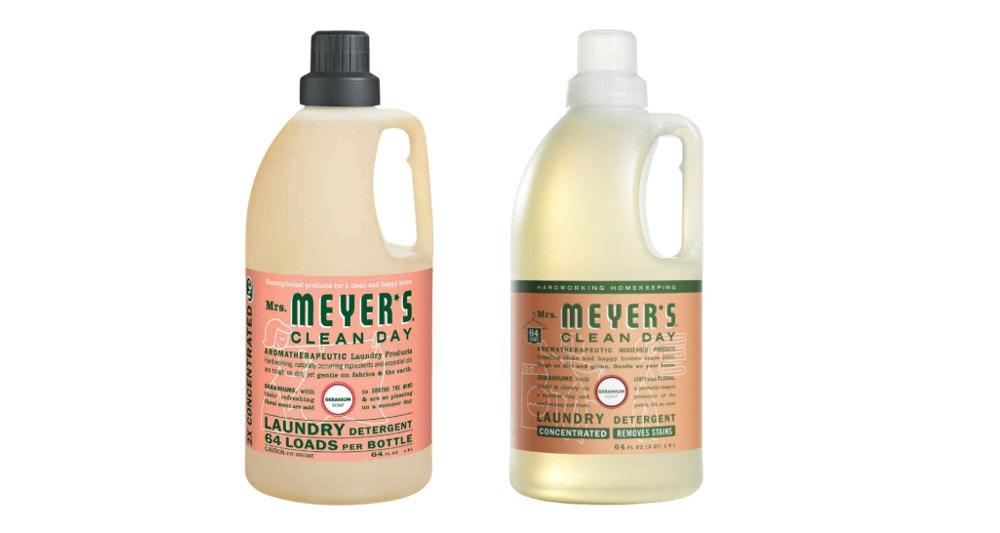Black plastic is one of the biggest recycling blind spots. SC Johnson is addressing this issue by removing it from the iconic Mrs. Meyer’s brand design.
For decades, black plastic packaging has been a challenge for recyclability. While most of us assume that when we toss a plastic bottle into the recycling bin, it will be transformed into something new, the reality is that black plastic often ends up in landfills, even if put in the right bin.
The problem isn’t that black plastic isn’t recyclable—it is. The challenge lies in the way recycling facilities sort materials. Most recycling facilities use near-infrared (NIR) scanners. These scanners identify and sort different types of plastics based on how they reflect infrared light. However, black plastic often contains a pigment called carbon black, which absorbs infrared light instead of reflecting it. As a result, the scanners often struggle to detect and sort it properly.
Considering how common black plastic is in packaging—from bottle caps to takeout containers—this presents a significant obstacle to improving plastic recycling rates. Even small black plastic components on an otherwise recyclable bottle can render the entire package challenging to process.
Recognizing this challenge, SC Johnson made a bold decision: phasing out black plastic from Mrs. Meyer’s packaging. Embracing this change, however, wasn’t as simple as removing black caps or sprayers. It required a rethinking – and letting go of – a thoughtful design element that had been part of the brand’s iconic identity for years.
Addressing Branding Considerations
One of the first things that stands out about Mrs. Meyer’s products is its packaging designed to align with the brand’s eco-conscious goals. The bottles are made from recyclable plastic, which supports the brand’s environmental mission. The design features botanical illustrations that reference the product’s garden-inspired scents and a balance of product information and brand messaging.
Consumers often consider both function and appearance when choosing products that remain visible in their homes, such as hand soaps and lotions. In packaging design, darker colors like black can be perceived as more distinctive or premium, which is why they are commonly used across categories. In this context, black plastic became a recognizable element of Mrs. Meyer’s brand identity.
However, removing black plastic raised questions about how the change might affect the product’s shelf visibility and customer familiarity. On crowded store shelves, packaging design plays a role in catching the eye and supporting brand recognition. The team needed to weigh the recyclability benefits against potential impacts on how easily consumers would recognize the product.
Finally, beyond branding issues, there was also the logistical challenge of ensuring a smooth transition to any new design. Changing packaging isn’t as simple as swapping one cap for another. SC Johnson needed to phase in the new clear caps and designs without creating confusion or leading to mixed packaging styles appearing on store shelves. This required careful coordination in manufacturing and distribution to prevent inconsistencies in the shopping experience.
Despite these challenges and concerns, SC Johnson decided to take action and remove black plastic from the product’s packaging, launching its first new Mrs. Meyer’s neutral cap product in September 2021 in the UK. The focus now is on removing black plastic from its laundry and home cleaning product lines, with the aim of eliminating it across the entire Mrs. Meyer’s product line by 2026.

The Bigger Picture: Designing for a Circular Economy
The decision to remove black plastic from Mrs. Meyer’s packaging might seem like a small change, but it highlights an important truth: even the smallest design choices can have a significant impact on recyclability.
Eliminating black plastic is just one step. SC Johnson has been rethinking packaging across its portfolio to ensure it is recyclable and designed for a circular economy. For example, SC Johnson replaced its flexible pouch refills for method® dish soap – which was made up of a combination of materials that made them unrecyclable – with rigid HDPE durables widely accepted by recycling programs.
Additionally, because standard thermoforming substrates commonly used for clear clamshell containers consist of mixed materials that cannot be easily recycled, SC Johnson is now swapping out blister thermoforms in its Duck® and Glade® brands’ packaging for paperboard options. Paperboard not only reduces plastic usage significantly but is also fully recyclable. The outer cardboard wrap can be easily removed and separated, simplifying recycling.
These and other packaging design changes have led to measurable impacts. Since signing onto the Ellen MacArthur Foundation (EMF) Global Commitment in 2018, SC Johnson has increased the individual recyclability of its packaging, resulting in over 12,000 metric tons of plastic that can be recycled or reused. SC Johnson has also cut its flexible packaging material footprint by 65%, eliminating over 20,000 metric tons of flexible materials.
A Reason to be Optimistic: Industry Collaboration and Ambitious Policy Action
To be clear, reducing the amount of plastic packaging and keeping it from becoming plastic pollution is a complex challenge that demands more than individual company efforts. Systemic change is needed, driven by ambitious regulation, unified standards and broad industry collaboration.
It’s why SC Johnson strongly supports The Consumer Goods Forum’s Golden Design Rules, which serve as a roadmap for making packaging more compatible with recycling infrastructure. Golden Design Rule #2 focuses on eliminating problematic elements, like undetectable carbon black pigments, which interfere with standard recycling technology. When adopted at scale, these voluntary rules can act as a stepping stone for global policy to help align the industry and lay the groundwork for the kinds of enforceable standards a global plastics treaty would deliver.
For more information on SC Johnson’s approach to reducing plastic waste and our actions to help more plastic enter the recycling stream instead of the waste stream, please visit our website.
This blog was written and contributed by: SC Johnson
